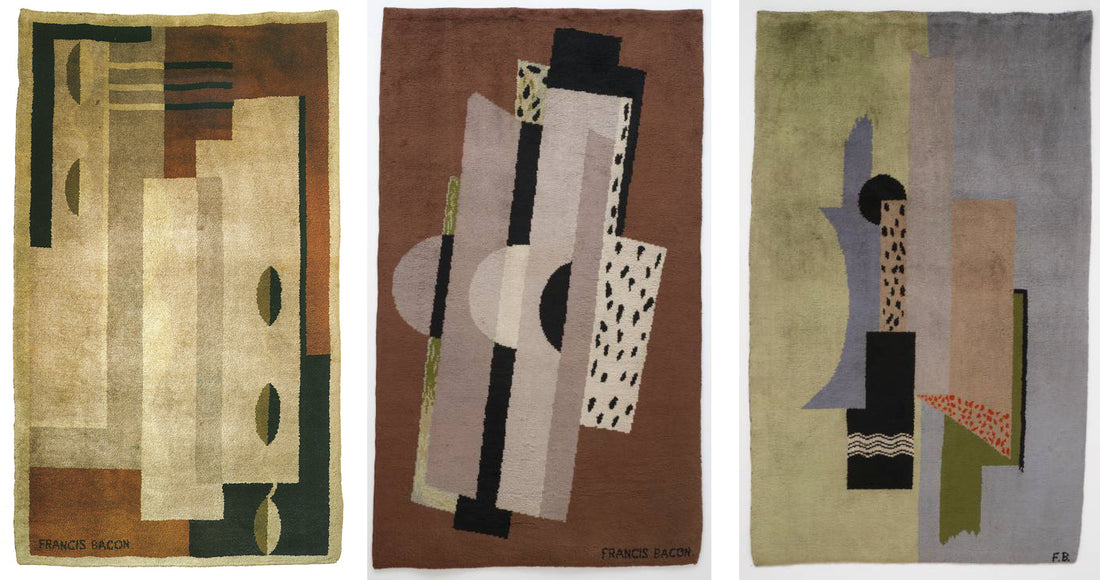
ARTISTS CARPETS & RUGS: FRANCIS BACON
Image: Three wool rugs by Francis Bacon. Image courtesy of The Estate of Francis Bacon
By Deborah Nash
Who would have guessed that the painter of screaming popes and tortured crucifixions had, in his youth, designed furniture and rugs? As Francis Bacon enjoyed the visceral effect his paintings had on the viewer, perhaps the surprise of his carpets would have amused him, too.
Francis Bacon (1909-1992) left school at 16 and never went to art school, but his curious and optimistic nature (despite the darkness of his subject matter) alongside the people he surrounded himself with contributed to his artistic development. Very little work survives from his early years when these rugs were made, as he destroyed much of it. The 12 rugs in existence created from 1929 to 1931 were made when he first moved to London following stays in Berlin and Paris. He installed himself in a studio at 7 Queensberry Mews, South Kensington, and produced a series of designs that were woven by the Wilton Royal Carpet Factory as part of their Wessex range.

Image: Wool rug by Francis Bacon 1929-30. Image courtesy of Victoria & Albert Museum, London
The rug above (L: 199cm x W: 140cm approx) is a calm arrangement of two dissimilar but overlapping rectangular blocks of grey and taupe, overlaid with three semicircles, two in white and one in taupe. It is made from wool pile, linen or jute warp and wool weft, (1929-30). It displays the influence of the collaged abstract geometry of Picasso’s synthetic cubism and includes Bacon’s signature, which appears on all his textiles, signalling his identity and vocation as an artist. It is now held in the V&A collections. The writer Patrick White, politician RA Butler and his wife and the art collector Douglas Cooper were the patrons of Bacon’s art deco output. In August 1930, The Studio magazine included a photograph of Francis Bacon’s atelier in Queensberry Mews, captioned ‘The New Look in British Decoration’, which featured one of his rugs and hailed him as one of England’s most inventive designers, just as he was turning towards painting.
By 1933, Bacon had abandoned interior decoration, but his subjects set in austere interiors with frames around them, may show the influence of his rug-designing days. Said Richard Calvocoressi, former director at the National Galleries of Scotland: "Bacon's first short career as an interior designer […] informed so much of his later painting - not least his feeling for space and structure."

Image: Wool rug by Francis Bacon. Image courtesy of The Estate of Francis Bacon
In April 2019, a Francis Bacon painted screen and three rugs came up for auction at Christies. Each rug was valued at between £146,000-£186,000. An export ban was placed on them to prevent the works leaving the country by the Department for Digital, Culture, Media & Sport. An indication of their value and their rarity.
SAVE THE DATE: Upcoming Selvedge online talk, Rugs, Wednesday 12 April 2023 at 18:00 BST (British Summer Time).
By Deborah Nash
Who would have guessed that the painter of screaming popes and tortured crucifixions had, in his youth, designed furniture and rugs? As Francis Bacon enjoyed the visceral effect his paintings had on the viewer, perhaps the surprise of his carpets would have amused him, too.
Francis Bacon (1909-1992) left school at 16 and never went to art school, but his curious and optimistic nature (despite the darkness of his subject matter) alongside the people he surrounded himself with contributed to his artistic development. Very little work survives from his early years when these rugs were made, as he destroyed much of it. The 12 rugs in existence created from 1929 to 1931 were made when he first moved to London following stays in Berlin and Paris. He installed himself in a studio at 7 Queensberry Mews, South Kensington, and produced a series of designs that were woven by the Wilton Royal Carpet Factory as part of their Wessex range.

Image: Wool rug by Francis Bacon 1929-30. Image courtesy of Victoria & Albert Museum, London
The rug above (L: 199cm x W: 140cm approx) is a calm arrangement of two dissimilar but overlapping rectangular blocks of grey and taupe, overlaid with three semicircles, two in white and one in taupe. It is made from wool pile, linen or jute warp and wool weft, (1929-30). It displays the influence of the collaged abstract geometry of Picasso’s synthetic cubism and includes Bacon’s signature, which appears on all his textiles, signalling his identity and vocation as an artist. It is now held in the V&A collections. The writer Patrick White, politician RA Butler and his wife and the art collector Douglas Cooper were the patrons of Bacon’s art deco output. In August 1930, The Studio magazine included a photograph of Francis Bacon’s atelier in Queensberry Mews, captioned ‘The New Look in British Decoration’, which featured one of his rugs and hailed him as one of England’s most inventive designers, just as he was turning towards painting.
By 1933, Bacon had abandoned interior decoration, but his subjects set in austere interiors with frames around them, may show the influence of his rug-designing days. Said Richard Calvocoressi, former director at the National Galleries of Scotland: "Bacon's first short career as an interior designer […] informed so much of his later painting - not least his feeling for space and structure."

Image: Wool rug by Francis Bacon. Image courtesy of The Estate of Francis Bacon
In April 2019, a Francis Bacon painted screen and three rugs came up for auction at Christies. Each rug was valued at between £146,000-£186,000. An export ban was placed on them to prevent the works leaving the country by the Department for Digital, Culture, Media & Sport. An indication of their value and their rarity.
SAVE THE DATE: Upcoming Selvedge online talk, Rugs, Wednesday 12 April 2023 at 18:00 BST (British Summer Time).
